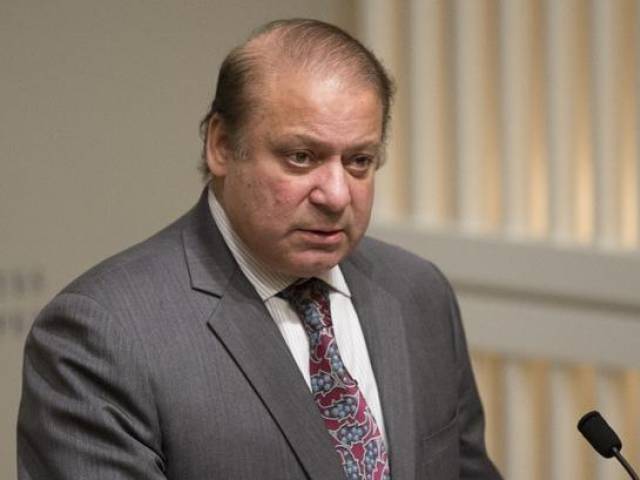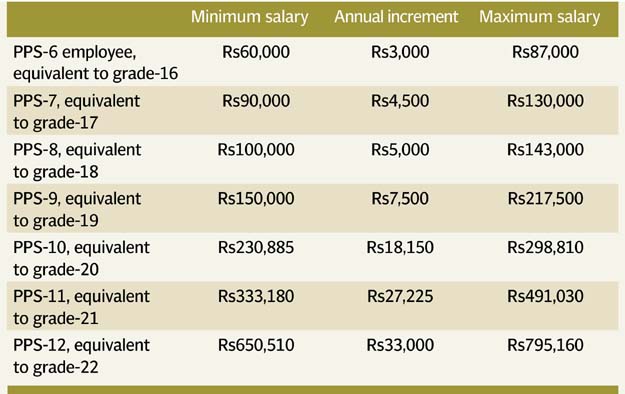
The revised pay package is in line with the salaries that regular government employees receive and also includes a 5% annual increment.
However, the government has capped maximum salary of each grade aimed at ending possibility of any misuse of the new Standard Pay Package. The maximum monthly salary under the new package has been fixed at Rs795,160.
PSDP 2017-18: Govt allocates Rs812m for 27 projects of info ministry
Prime Minister Nawaz Sharif has already approved the revised pay package for the project staff. The government had recently announced that it would increase salaries of its regular employees by 10% after merging previous ad hoc allowances into their basic pay.
The fresh pay package will come into force with immediate effect and all the previous pay packages announced in 2009, 2011, 2013 and 2016 have been replaced, according to a decision taken by the Economic Coordination Committee of the cabinet this week.
However, revised PC-I of projects are required to be approved for the adoption of new pay packages.
The government had to revise the pay packages after it cut salaries of the contractual employees of development projects due to objections raised by the Accountant General of Pakistan Revenue (AGPR).

These contractual employees were getting salaries approved in PC-I of the projects. But the AGPR did not recognise these salaries.
New package
The package has been finalised after a series of meetings between the Ministry of Finance, Ministry of Planning and Establishment Division. Federal secretaries of these ministries have already signed a note in this regard.
The minimum salary under the revised package will be equivalent to the minimum wage.
The pay packages will be given to fresh, direct and existing employees of the Public Sector Development Programme (PSDP) projects. However, the pay will be fixed at the initial stage and thereafter an annual increase of 5% will be given.
The minimum monthly salary for the highest pay scale employee hired under the Project Pay Scale (PPS) has been fixed at Rs650,510 in addition to 5% annual increment amounting to Rs33,000.
The highest PPS-12 employee will be equivalent to a grade-22 officer of the federal government. His maximum salary has been capped at Rs795,160. For PPS-11, equivalent to grade-21, the minimum salary will be Rs333,180 with Rs27,225 as increment and the maximum salary will be Rs491,030.
For PPS-10, equivalent to grade-20, the minimum salary will be Rs230,885 with Rs18,150 annual increment. The maximum salary will be Rs298,810 per month.
Based on the sensitivity and size of PSDP projects, the Central Development Working Party will decide on whether the project director should be placed in PPS-10, PPS-11 or PPS-12.
The minimum salary for PPS-9, equivalent to grade-19, will be Rs150,000 per month, Rs7,500 as annual increment and the maximum salary will be Rs217,500.
For PPS-8, equivalent to grade-18, the minimum salary will be Rs100,000 with Rs5,000 annual increment and maximum salary will be Rs143,000. For PPS-7, equivalent to BPS-17, the minimum salary will be Rs90,000 with annual increment of Rs4,500 and the maximum salary will be Rs130,000.
The PPS-6 employee, equivalent to grade-16, will draw minimum salary of Rs60,000 with annual increment of Rs3,000 and maximum salary of Rs87,000 per month.
Government’s regular employees may also apply for the PSDP-funded project posts, but they will have to resign from government service before their appointment.
Rs663m project to be included in PSDP
Project employees will be appointed on contract for an initial period of two years which will be extendable further till completion of the project on a yearly basis after performance evaluation. No additional facility, in addition to the revised standard pay package, will be allowed to the PSDP project employees.
Published in The Express Tribune, June 9th, 2017.
Like Business on Facebook, follow @TribuneBiz on Twitter to stay informed and join in the conversation.

1725030039-0/Untitled-design-(2)1725030039-0-165x106.webp)















COMMENTS (1)
Comments are moderated and generally will be posted if they are on-topic and not abusive.
For more information, please see our Comments FAQ